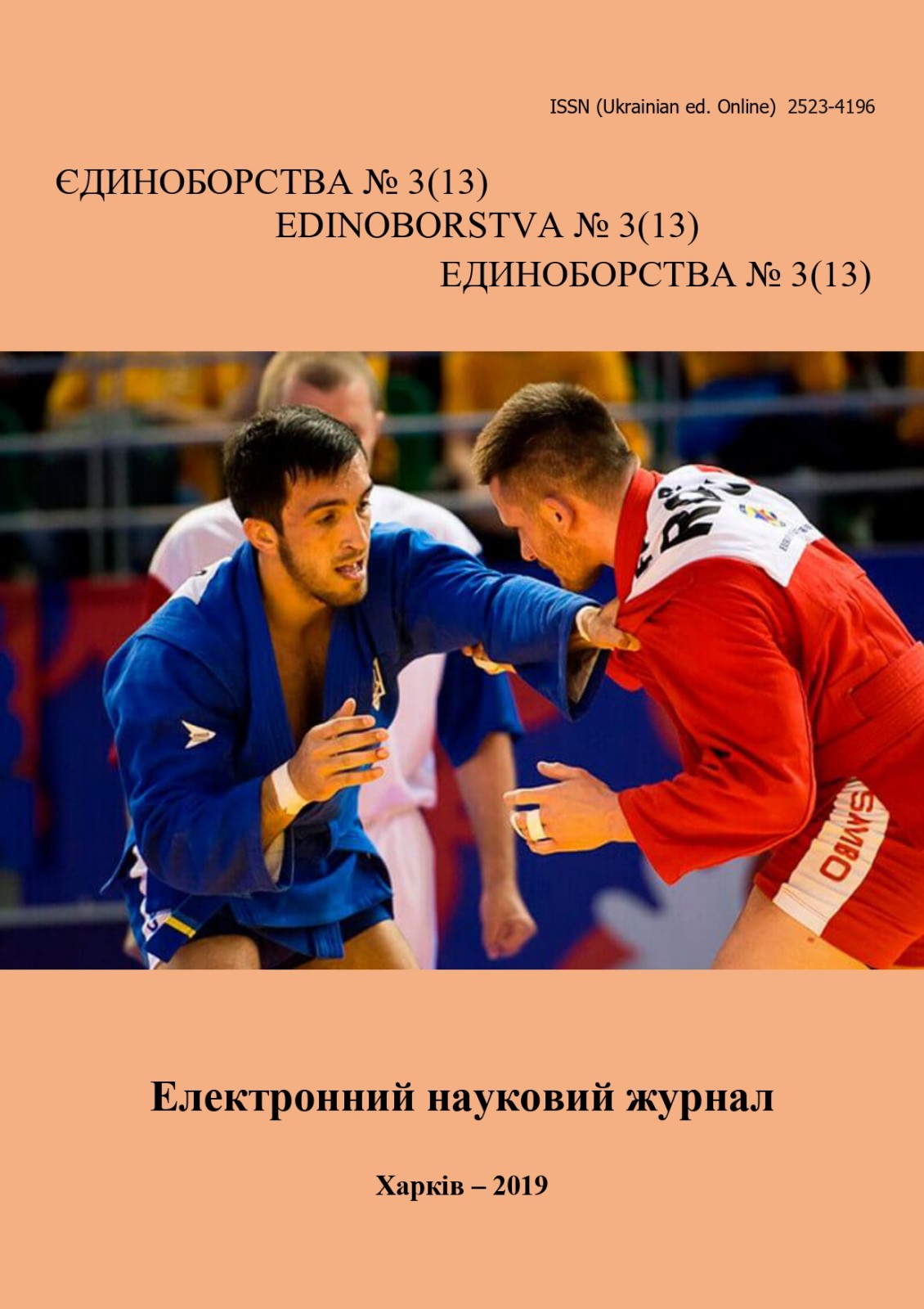The general structure of coordination abilities of taekwondo sportsmen 12–14 years
DOI:
https://doi.org/10.15391/ed.2019-3.06Keywords:
Taekwondo, coordination abilities, sensory systems, factor analysisAbstract
Purpose: to identify the most significant factors and their in formativeness in the overall structure of coordination abilities of young taekwondo sportsmen. Material and methods. The study was conducted in real conditions of the training process of young taekwondo sportsmen. The study was attended by children, 15 people in control and experimental groups, aged 12–14 years, who are engaged in basic training groups. The research was carried out on the basis of KDUssh №2, Kharkiv. The research used the following research methods: theoretical analysis and generalization of scientific and methodological literature and the Internet, pedagogical observation, generalization of practical experience of leading trainers, pedagogical testing, methods of mathematical statistics. Results. Factor analysis performed on the basis of these variables obtained as a result of testing that characterizes the coordination readiness of young taekwondo sportsmen at the basic training stage include: the first, the general factor is 22.48%; this is a factor that reflects the visual orientation and the ability to maintain a static equilibrium; the contribution of the second factor, the ability to differentiate efforts and rebuild movements is 17.4%, the contribution of the third factor to the structure of overall coordination preparedness is 12.85%, the contribution of the fourth factor - (10.74%), the contribution to the factor for the coordination of movements (9,18 %), the ability to manage movements in the overall structure - (8.75%). Conclusions. 1. Analysis and synthesis of scientific and methodological literature and materials of the Internet network allowed to establish that the development of coordination abilities is one of the core foundations of the whole process of training young taekwondo sportsmen. Questions of the structure and interconnection of the components of coordination preparation of young taekwondo sportsmen in the basic preparation stage remain unresolved. 2. Analysis of the structure of indicators revealed that after the experiment, the coordination preparation structure is characterized by a decrease in the number of factors in the experimental group compared with the control. The reduction of the factors testifies to the optimization of the system of coordinating preparedness of the experimental team of taekwondo sportsmen. 3. It was found that the structure of indicators of co-ordination preparedness of taekwondo sportsmen of the experimental and control groups shows that there are the most significant orthogonal factors that largely reflect the visual orientation and the ability to maintain a static equilibrium and the ability to differentiate efforts and rebuild movements (ability to control their movements, ability, to the frequency of movements).
References
Ашанин, В. С., & Романенко, В. В. (2015). «Использование компьютерных технологий при оценке сенсомоторных реакций в єдиноборствах». Слобожанський науково-спортивний вiсник, № 4(48), 15–18.
Бойченко, Н. В. (2014). «Контроль координаційних здібностей в ударних видах єдиноборств». Слобожанський науково-спортивний вісник, №6 (44), 15–18.
Макаренко, М. В., & Лізогуб, В. С. (2014). Онтогенез психофізіологічних функцій людини. «Вертикаль», Черкаси.
Пашков, І. М, & Доморніков, С. О. (2017). «Особливості прояву координаційних здібностей в тхеквондо». Единоборства №1, 45–49.
Пашков, І. М. (2012). «Розвиток координаційних здібностей єдиноборців». Проблемы и перспективы развития спортивных игр и единоборств в высших учебных заведениях, сборник статей VIII международной научной конференции. Белгород – Харьков – Красноярск: ХГАФК, 145-148
Пашков, И. Н. (2007). «Роль сенсорных систем при развитии координационных спосібностей». Слобожанський науково-спортивний вісник, № 12, 281–285.
Платонов, В. Н. (2015). Система подготовки спортсменов в олимпийском спорте. Общая те- ория и ее практические приложения: учебник [для тренеров] : 2 кн. Олимп. лит., Киев.
Ровний ,А. С., & Лизогуб, В. С. (2016). Психосенсорні механізми управління рухами спортсменів: монографія. Xарків.
Ровный, А. С., Романенко, В. В. & Пашков, И. Н. (2013). Управление подготовкой тхеквондистов. Монография. Харьков.
Ровний, А. С., Ільїн, В. М. , Лизогуб, В. С. & Ровна, О. О. (2015). Фізіологія спортивної діяльності. ХНАДУ, Харків.
Романенко, В. В. (2017). Современные компьютерные технологии в профессиональной деятельности единоборцев. Методические рекомендации. Харьков: ХГАФК.
Pashkov, I. N. (2015). «Methodic of coordination’s perfection of junior taekwondo athletes at stage of pre-basic training». Pedagogics, psychology, medical-biological problems of physical training and sports, vol.5, 27–31.
Podrigalo, L., Iermakov, S., Potop, V., Romanenko, V., Boychenko, N., Rovnaya, O., & Tropin, Y. (2017). «Special aspects of psycho-physiological reactions of different skillfulness athletes, practicing martial arts». Journal of Physical Education and Sport, Vol. 17, iss. 2, 519–526.
Rovniy, A., Pasko, V., Karpets, L., Lyzogub, V., Romanenko, V., Pashkov, I., Dzhym, V., & Dzhym, Y. (2018). «Optimization of physical loads as a basis for formation of the coordination features of young taekvondo athletes». Research journal of pharmaceutical biological and chemical sciences, № 9(5), P. 2216–2225.













